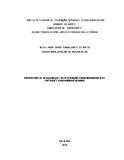Dispositivo de segurança e identificação para moradores de prédios e condomínios - DISIMP

Visualizar/
Data
2018-11-23Autor
Brito, Aldielyson Jorge Cavalcante de
http://lattes.cnpq.br/209276371784577
http://lattes.cnpq.br/2092763717845771
Silva, Nicodemos Jonatas de Moura
Metadado
Mostrar registro completoResumo
This work aims to create an access control device, from the development
of an easy-to-use prototype. It is a Security and Identification Device
for Residents of Buildings and Condos (DISIMP), which operates through
an Arduino microcontrolled platform. For this equipment, user interface peripherals
are used, such as the LCD display and the matrix keyboard, in
addition, its command is made by means of a radio transmitter TX4R 3.0
JFL Rolling Code 433,92MHz (FS1000A) (RF). The great differential of this
project is an artifice for coerced actions, that is, when user input is being
imposed by some external threat. In this way, DISIMP has in its command
a panic button for coincidences of this magnitude, in which an alert will be
issued for the doorman to make the appropriate decisions. The equipment
developed, through the insertion of a Micro SD memory card, allows the
configuration and storage of data of 160 different residents, with possibility
of expansion. In this sense, the viability of the project can be demonstrated
by its differential and practicality.



